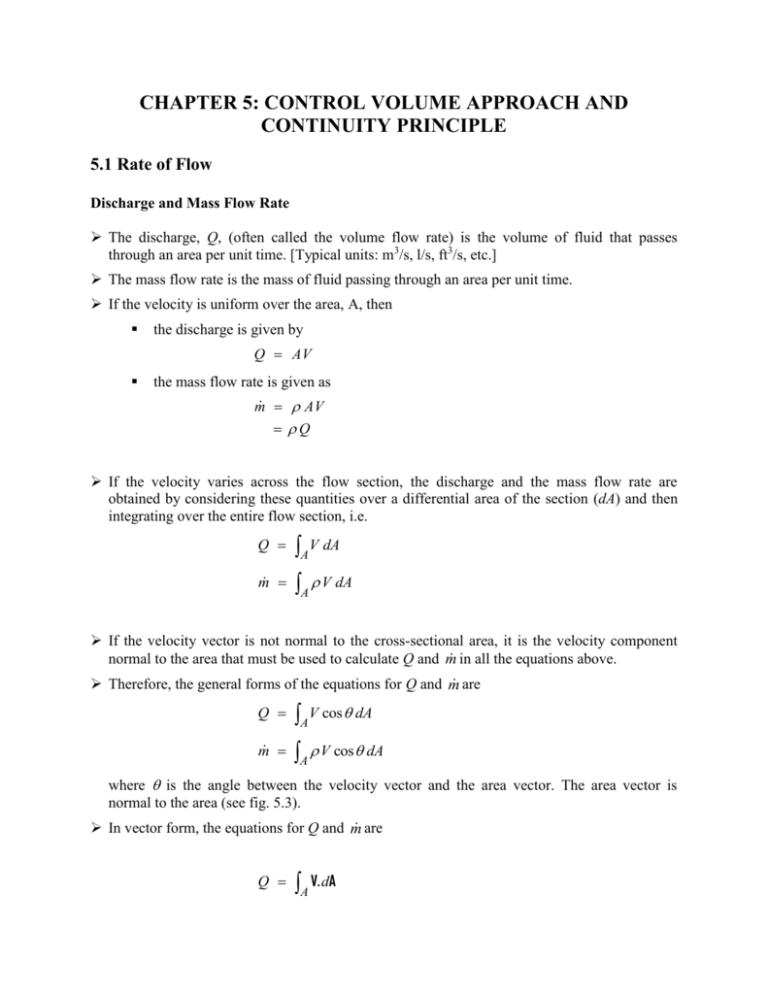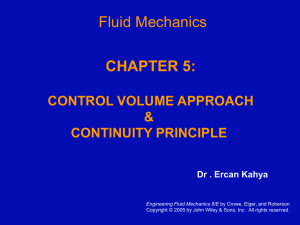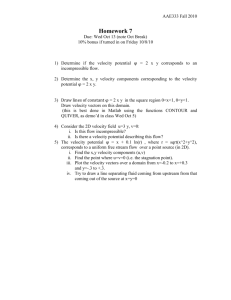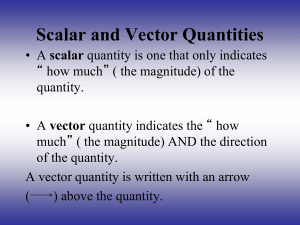doc
advertisement

CHAPTER 5: CONTROL VOLUME APPROACH AND CONTINUITY PRINCIPLE 5.1 Rate of Flow Discharge and Mass Flow Rate The discharge, Q, (often called the volume flow rate) is the volume of fluid that passes through an area per unit time. [Typical units: m3/s, l/s, ft3/s, etc.] The mass flow rate is the mass of fluid passing through an area per unit time. If the velocity is uniform over the area, A, then the discharge is given by Q AV the mass flow rate is given as m A V Q If the velocity varies across the flow section, the discharge and the mass flow rate are obtained by considering these quantities over a differential area of the section (dA) and then integrating over the entire flow section, i.e. Q AV dA m A V dA If the velocity vector is not normal to the cross-sectional area, it is the velocity component in all the equations above. normal to the area that must be used to calculate Q and m are Therefore, the general forms of the equations for Q and m Q AV cos dA m A V cos dA where is the angle between the velocity vector and the area vector. The area vector is normal to the area (see fig. 5.3). are In vector form, the equations for Q and m Q A V. dA m A V. dA The differential areas for a circular and a rectangular cross-section are shown below. dr dy r H y R 2 r dr dr b dA r dr 2 r 2 2 dA b dy 2 r dr Mean Velocity If the discharge is known, the mean velocity over the flow area is given as V Q A Example: Problem 5.8 The hypothetical velocity distribution in a circular duct is v/Vo = 1-r/R, where r is the radial location in the duct, R is the duct radius, and Vo is the velocity on the axis. Find the ratio of the mean velocity to the velocity on the axis. Solution: To be presented in class. Example: Problem 5.18 An empirical equation for the velocity distribution in a horizontal, rectangular, open channel is given by u = umax(y/d)n, where u is the velocity at a distance y feet above the floor of the channel. If the depth of flow is 1.2 m, umax = 3 m/s, and n = 1/6, what is the discharge in cubic meters per second per meter of width of channel? What is the mean velocity? Solution: To be presented in class. 5.2 Control Volume Approach The control volume approach is the method whereby a volume in the flow field is identified and the governing equations are solved for the flow properties associated with this volume. System, Control Volume, and Control Surface A fluid system is a continuous mass of fluid that always contains the same fluid properties. The mass of a system is constant. A control volume (cv) is defined as a volume in space. It can deform with time as well as move and rotate in space. The control surface (cs) is the surface enclosing the control volume. The mass in the control volume can be changing with time as a result of mass flowing into or out of the control volume, by crossing the control surface. Consider the tank of liquid shown in fig. 5.4, with flow into and out of the tank. The control volume and the control surface are defined as shown in the figure. The following can be said about the mass of liquid in the control volume: The change in mass (of the liquid in the control volume) over a period of time is M cv M in M out This is the law of conservation of mass. It is called the continuity principle. The rate form of the continuity principle is dM cv m in m out dt in and m out are the mass flow rate into and mass flow rate out of the control where m volume, respectively. Intensive and Extensive Properties The extensive properties of a system are proportional to the mass of the system. They include mass, M, momentum, Mv, and energy, E. The intensive properties of a system are independent of system mass. They are obtained by dividing the extensive properties by the system mass. The intensive property for mass is unity, for momentum v, and energy e. The relationship between an extensive property B contained in a control volume and the corresponding intensive property b is Bcv cv b dm cv b dV Property Transport across the Control Surface Consider the flow through the duct in fig. 5.5. For uniform velocity across a surface, the mass flow rate is given by m V . A where V is the velocity of flow with respect to the surface and A is the area vector. The direction of the area vector is normal to the surface and pointing outward away from the control volume. The discharge into and out of the control volume are V1 . A1 = -V1 A1 V2 . A2 = V2 A2 The net mass flow rate out of the control volume is net mass flow rate = 2 V2 A2 - 1 V1 A1 = 2 V2 . A2 + 1 V1 . A1 V . A cs The general form of the net rate of flow of the extensive property from the control volume is B net cs b V . dA Reynolds Transport Theorem The Reynolds transport theorem is the Lagrangian-to-Eulerian transformation of the rate of change of an extensive property. Consider a system moving through a control volume as shown in fig. 5.7. The Reynolds transport theorem for the extensive property B is (see textbook for proof): dBsys dt Lagrangian Eulerian For multiple inlet and outlet ports, and uniform velocity, density and b across each port, the equation can be simplified to dBsys dt d b d V c.s. b V dA d t c .v . d b d V b V A d t c .v . cs The above equation can be written in terms of mass flow rates as dBsys dt d b d V m o bo m i bi d t c .v . cs cs where the subscripts i and o refer to the inlet and outlet ports, respectively. 5.3 Continuity Equation In Lagrangian form, the conservation of mass principle is Msys = const The Eulerian form of the conservation of mass is obtained by applying the Reynolds transport theorem. Substituting Bcv = Msys, b = 1, and noting from the above equation that dMsys/dt = 0, the continuity equation is obtained as d d V c.s. V d t c .v . dA 0 i.e. the rate of accumulation of mass in the control volume plus the net mass efflux through the control surface is zero. If the mass crosses the control surface through a number of inlet and exit ports, the continuity equation simplifies to d M cv m o m i 0 dt cs cs If there is only one inlet and one outlet port, the equation reduces to d M cv m i m o dt Continuity Equation for Flow in a Pipe Consider flow through a pipe section as shown in figure 5.9. If the flow is steady, Mcv is constant and the continuity equation becomes m 2 m 1 For uniform velocity and density, the equation reduces to Q2 Q1 A2 V2 A1 V1 If there are more than two ports, the continuity equation for steady flow is m i m o cs cs ible incompress Qi Qo cs cs Example: Problem 5.76 Air with a density of 0.0644 lbm/ft3 is flowing upward in the vertical duct, as shown. The velocity at the inlet (station 1) is 100 ft/s, and the area ratio between station 1 and 2 is 0.5 (A 2/A1 = 0.5). Two pressure taps, 10 ft apart, are connected to a manometer, as shown. The specific weight of the manometer liquid is 120 lbf/ft3. Find the deflection, h, of the manometer. Solution: To be presented in class. 5.4 Cavitation Cavitation is the formation and subsequent collapse of vapor bubbles due to the reduction of the liquid pressure to the local vapor pressure. In flowing fluids it is possible to have very low pressure due to the fluid motion. The liquid will boil if the pressure is lowered to the vapor pressure. This may occur in flow through the irregular, narrowed passages of a valve, the suction side of a pump, a pipe restriction, etc. The vapor bubbles formed will collapse in regions of higher pressure downstream. Cavitation produces shock waves, noise, decreased equipment performance, and equipment failure. Therefore, it should be avoided. Figure 5.10 illustrates the occurrence of cavitation in a pipe restriction. Figure 5.11 shows the formation of vapor bubbles, which leads to cavitation, in a venturi meter. The cavitation index, , is defined as the negative of the pressure coefficient where cavitation occurs. po pv 1 Vo2 2 where po, Vo are the freestream pressure and velocity, respectively. Pv is the vapor pressure of the liquid. Cavitation occurs whenever is less than the critical cavitation index crit. 5.5 Differential Form of the Continuity Equation The differential form of the continuity equation can be derived by applying the continuity equation to an infinitesimal control volume and taking the limit as the volume approaches zero. The differential form of the continuity equation for a homogeneous fluid is stated as follows: u v w 0 t x y z If the flow is steady, we obtain u v w 0 x y z If, in addition to being steady, the flow is also incompressible, we obtain u v w 0 x y z In vector notation, the continuity equation can be written as D .V = 0 Dt where is the del operator, defined as i j k x y z For steady incompressible flow, the vector form of the continuity equation is .V = 0 Example: Problem 5.93 A u component of velocity is given by u = Axy, where A is a constant. What is a possible v component? What must the v component be if the flow is irrotational? Solution: To be presented in class.








